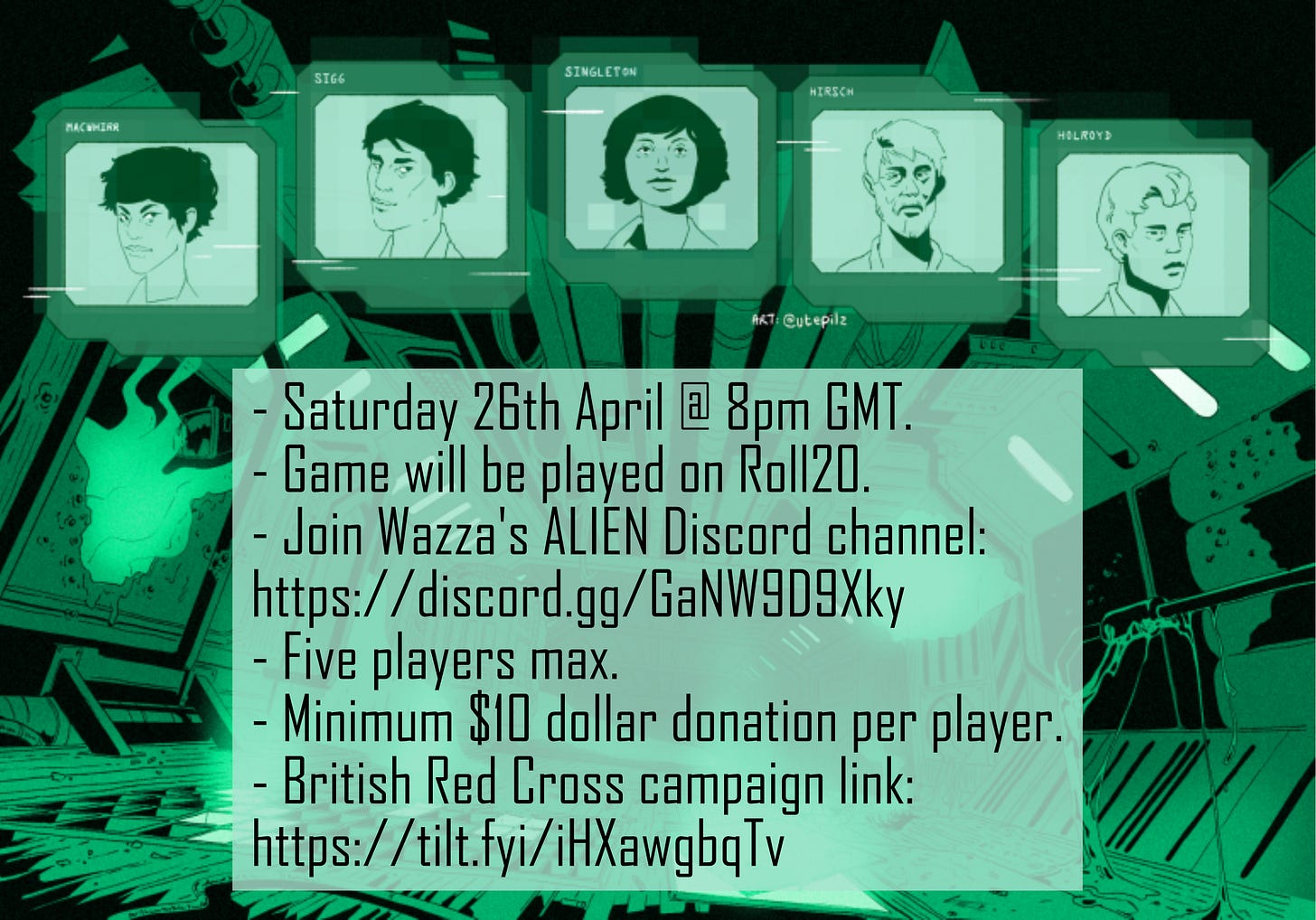Welcome to our RPG community newsletter!
Hi. I’m K.J.
Today:
Warren Davidson (Wazza’s Whimsical Wanderings) reviews Reanimated.
PocketQuest 2025: I share thoughts on brainstorming.
Wazza is running an ALIEN game for the British Red Cross and YOU can sign up below!
- offers the final section of the free dungeon map pack.
Want to connect more with community? I post Notes every 3-4 days to bring us together and share ideas. I hope you’ll join in the conversation.
🎲Review: Reanimated
a review by Warren Davidson (Wazza)
A quick disclaimer, Trapped Chest sent me a review copy. I didn’t receive any other form of compensation.
“It's close to midnight and something evil's lurkin' in the dark.”
“Darkness falls across the land. The midnight hour is close at hand
Creatures crawl in search of blood to terrorize y'all's neighbourhood.”
How do you think the world will end? A colossal asteroid on an earth shattering collision course? The four horsemen of the apocalypse sweeping across the globe bringing fire, famine, plague and death? Terrifying Aliens in multi-legged killing machines destroying everything in their path with matter-obliterating death rays? Will A.I. finally realise humans are worthless and subvert our world dominance by turning our own technology against us by taking over our cell phones? or maybe the dead will crawl out of their graves and consider us breakfast, lunch and dinner? If it’s the latter then this is the RPG for you!
Reanimated is a Table Top Roleplaying game where you play survivors of this last calamitous event, that’s right a zombie apocalypse! Reanimated was written by Jed Doerksen of Trapped Chest.com and is available as a free download from DriveThruRPG and Itch.io. You can purchase a print copy from Compose Dream Games for $17 plus shipping. The game has a full colour cover showing a member of the recently departed arriving for dinner and a rear cover blurb. I must say the print version has lovely glossy paper in a portable 8.5” by 5.5” format. The game weighs in at 22 pages, with a quick reference rules sheet at the front and a character sheet at the back. Everything is presented in an easy-to-read two-column back and white format.
So what about the game itself? It uses the “Key Powered System” having you roll 2D8, add in ability modifiers to equal or beat a target number. An edge and fault mechanic has you roll 3D8 and choose the best or worst 2D8 depending on circumstance. Characters assign points to the core stats of Strength, Dexterity and Mental and choose one of seven classes which provide additional benefits in the form of edge on certain skills, more hit points (always a good thing) and infection resistance (a very good thing). My favorite class is the Junkie who hasn’t even realised the world has come to an end! Skills are assigned to a core stat with a total of fifteen to choose from. There's a page on the equipment covering weapons and armour, before the chapter on using them to fight the undead hordes.
During combat you move, take standard actions such as attacking and administering first aid to fallen comrades and open doors and draw weapons with free actions. To hit that shambling zombie breaking through the door in front of you roll 2D8 and add your melee or shoot skill to beat their block or dodge roll. Most Zombies do neither so that’s some small relief. Damage is calculated using edge and fault mechanics, so roll 3D8, if the weapon is low powered choose the worst two, and the best two if it’s high powered. Roll doubles and you double the damage. Opportunity attacks will bring down the reckless and death occurs when you drop to negative hit points. It’s lethal so don’t expect to go toe-to-toe with zombie hordes for long!
Next up is my favorite chapter, zombies! What we have here is a toolbox for creating any type of undead you can dream up in your fevered imagination.
Want the classic Night of the Living Deader? check. How about mixing things up with a super quick sprinter or a hulking brute? Check. And scare your complacent players to death with a zombie that's smarter than they are! zombies with guns? Surely not! We also have advice on their appearance and possible mutations. There’s enough variation here to make each zombie unique. Oh, and infection is a big deal, get bitten and you’ll be joining the undead ranks very soon. Drastic measures in the form of amputation may be your only recourse.
The book rounds out with some useful GM advice and a couple of sample zombies to get you started. This game could easily be dove-tailed into the setting of your choice be it the classic modern day or even the wild west. Why not use it to complement the plethora of zombie games already out there? All Flesh Must be Eaten, Dead Reign, The Walking Dead and Zombicide spring to mind. So if you want a fun game of surviving a zombie apocalypse Reanimated meets all your undead needs.
🎨Making…But First, Brainstorming for PocketQuest
In the last newsletter, I mentioned brainstorming on a potential PocketQuest 2025 entry. I’ve spent the last week taking notes on my ideas relating to this year’s theme of “Dreams and Nightmares” with the hope that a workable (and perhaps enjoyable) game of some sort will come out of this.
Let’s talk about brainstorming to create something, whether that something is a game, adventure, short story, or artwork. Since beginning this experimental journey into publishing indie tabletop RPG material, I’ve noticed these two ideas continually suggested by folks for creating stuff:
mash-up different ideas
“steal” other people’s ideas
Let’s briefly address these one at a time and then identify better brainstorming.
Mashing up different ideas. When I was just starting this journey, I took an informal course by a certain game creator. I had no idea who was who and what was what, so in 2021-2022, this seemed like a no-risk, cost-effective way to learn about how to make games. The instructor asked participants to cut up several strips of paper and just write down one word nouns or things. We were then to scramble them up and draw two or three from the mix, using what we drew to create a very basic game following a certain procedure.
I had a couple of friends join me and so we had three games when it was all said and done. This mashing up of random and unrelated ideas made NO sense. The games were not enjoyable.
My advice: Don’t do this. Make intentional choices, not random ones. The juxtaposition of various ideas should be thoughtful, not haphazard. We need good, playable games and enjoyable stories - not just more games and books.
“Stealing” other people’s ideas. When I scan multiple comments across creative spaces, most folks seem harmless when they exclaim, “I’m stealing that idea!” But let’s address the idea really of skimming off others without doing the hard work and flexing our own creative muscles.
With well over 8 billion people currently living on the planet (let alone how many billions have ever lived), it can feel as if there really is nothing new under the sun. Trying to be original can feel like a waste of time in a world that seems to value output and productivity. Ignore all that noise in the background of your creative journey.
You may never make a best-selling game or book or whatever, but don’t sell yourself out to try and reach that goal.
My advice: Be inspired by others while remaining true to yourself as a creator. Doing this preserves the value of your own ability to create things. Keep creating, even if you never share it with others, as this will strengthen your creative muscles.
So what does brainstorming look like? This largely depends on your personality and personal creative process. Here’s a very short list of resources that explain brainstorming in various ways. Check them out and use the ideas that work for you:
Suggestions from my own brainstorming:
Quietly ponder on the theme or main idea for the adventure or story. I do this for days before taking any action. I just soak in the various thoughts.
Write down stuff whenever your internal, creative voice speaks something that impresses you. Perhaps it’s a part of a dialogue. Other times, it may be a first-person narration.
Get away from my workspace. I live in the country, so the drives filled with nature on my way to the nearest city often “speak” to me. Getting out for fresh air and the beautiful scenery really resets my mind and soul for thinking on how to make ideas actionable.
Give both yourself and your idea space and time. I walk away from something, allowing myself to think about other aspects of life. Doing other tasks can often bring the next part of a story idea to me. This used to be hard for me, as I previously believed that being obsessed with a project meant not walking away from it. This is not healthy for you nor your idea.
If any of this is helpful, leave a comment below. Also, let me know how you brainstorm.
Wazza’s ALIEN RPG Fundraiser Game & How YOU Can Join
Schlau’s Free Maps
Here’s the final section of the larger dungeon map pack. This map series looks great in print. Schlau recommends using a local print shop for best results. If you’ve missed the other portions, you can download those via the Dropbox link below. Enjoy!
Until next time, remember:
Newsletters are free.
Thorvald was the oldest European hedgehog. He was 16 years old.
Disclosure: Newsletters may contain affiliate links at no cost to you or the creators.
Thanks for reading Watch Well Games. Subscribe to get our free newsletter every 2nd and 4th Friday.

















The two ideas, "getting away from your workspace" and "writing down your ideas as they come to you," are critical.
Seeing and experiencing people, places, and things always generates new ideas. Also, having some method of recording your thoughts before they flee is essential.
I take a small notebook/journal everywhere. Some may use a phone app to write, voice record, or something else. Taking interesting photos is great for capturing a vibe or moment - even if you don't consider yourself a photographer.
No one but you has to see your notes.
On "stealing" others ideas: I remember a great quote it took me a few years to understand - Good artists borrow, Great artists steal.
In stealing an idea or work of another, you must develop or and modify it to make your own.
An example; take a song - you change the lyrics, you change the tempo, you change some of the chords. Technically, you started by stealing but finished with an effectively new work.
Many graphic artists and many classical painters started by copying the work of others and then progressed to develop their own creative voice.
If you start with stealing another persons work, focus on how to make it into something uniquely your own.